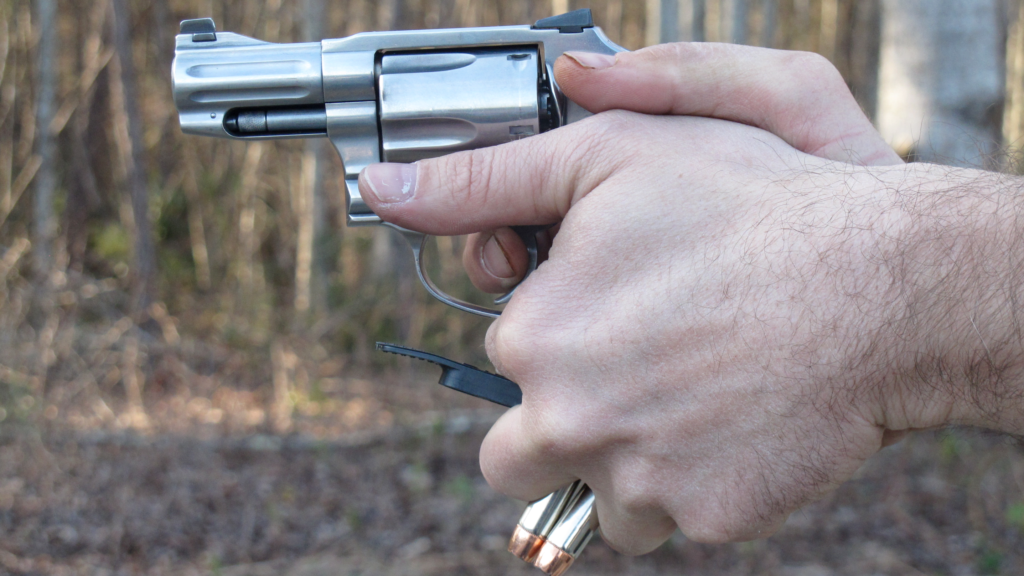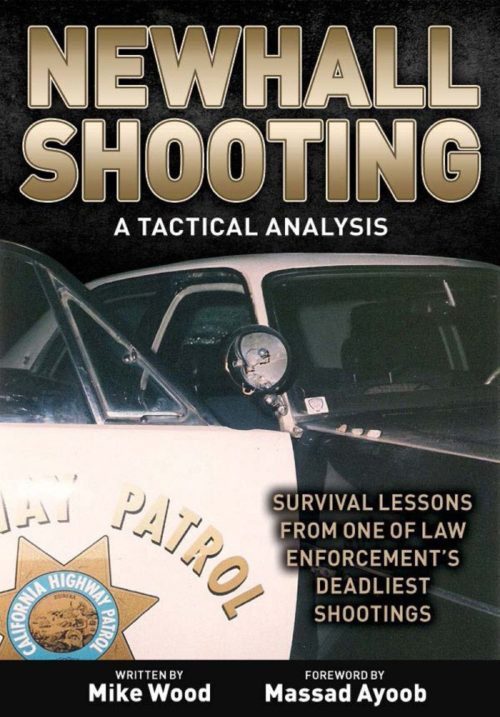I have been traveling a lot lately, so my shooting has been mostly limited to dry-practice. I have been thinking about revolver reloads an awful lot, and I’ve actually had time to read a little. I recently finished Newhall Shooting – A Tactical Analysis by Mike Wood. As one with an interest in revolvers, I am also keenly interested in what can be learned from historical events in which the participants used revolvers.
The Newhall Shooting is stuff of absolute legend. Moments before midnight on April 5th, 1970, two hardened criminals were pulled over by California Highway Patrolmen; four minutes later, four Patrolmen lay dead, the result of a tragic and desperate gunfight. Even if you’ve never heard of the Newhall Shooting there is a very good chance you’re aware of one very common tidbit of gun “wisdom” that arose from it. The Newhall Shooting is the event that sparked this old saw: “state troopers were found dead with brass in their pockets because they picked it like they were on the range”.
The Newhall Shooting – A Tactical Analysis
There is no better place to learn about the Newhall Shooting than Mike Wood’s book, Newhall Shooting – A Tactical Analysis. The first major portion of the book is dedicated to recounting the gunfight itself. Gun battles are fluid, disorderly affairs. Multitple parties are maneuvering and shooting at once, and dozens of other factors like injuries and the actions of bystanders are in play. Giving a story like this its full due, while still managing to keep it comprehensible to the reader can be a challenge. Mr. Wood’s recounting of the Newhall shooting is without peer. Each participant’s action is explained in concise, overlapping accounts, each of which contributes to, and interplays with, the overall scene. All of this adds up to a gut-wrenchingly detailed replay of the tragedy at Newhall.
The research that went into this work is phenomenal. Wood interviewed primary sources, including Mr. Gary Kness†, a bystander who ran to the sound of guns at Newhall in an attempt to aid the desperately wounded officers. Wood’s research also touched the murder investigation conducted by the Los Angeles County Sheriff’s Department, and the subsequent inquiry by the California Highway Patrol. The book is richly illustrated with photographs from the crime scene and from the CHP’s archives.
In fact, the idea for Newhall Shooting began as a research project. I reached out to Mr. Wood before this publication to request a cover photograph, and our correspondence resulted in several long phone calls and email chains, during which he explained the origin of Newhall Shooting. Wood had begun writing an account of the historical duty weapons and ammunition of the California Highway Patrol (this research project makes up the book’s appendix: “A History of CHP Firearms, Equipment, and Firearms Training”). It eventually turned into something much more.
The book’s beginnings as a research project are evidenced throughout the remainder of the work, as well. Wood goes on to discuss the state of training within the California Highway Patrol (and to some extent in law enforcement generally) in 1970. Predictably, “combat shooting” had not made the inroads into law enforcement that it has in more recent years. In the third section of the book, Wood conducts a thorough analysis of the gunfight. This analysis is balanced against Massad Ayoob’s “Priorities of Survival” and the role each played, as well as some “what ifs”. The final section of this work, “Where Are We Now” takes a look at the state of law enforcement training today.
There are a number big lessons that can be – and have been – drawn from this book. These lessons were applied to law enforcement rapidly and are still in evidence today. Modern “felony traffic stop” procedures can trace their lineage directly to that parking lot in Newhall, and the shooting influenced dozens of other facets of law enforcement tactics, directly and indirectly. Many of these lessons are also applicable to students of self defense generally, and to revolver-shooters specifically. I will let you discover most of them for yourself, among the pages of Newhall Shooting – A Tactical Analysis. However, I will examine one of these lessons-learned and how it has directly impacted my training regimen.
Practical Take-Away
Though the deaths of all the Officers at Newhall were tragic, one stands out hauntingly in my mind. Officer James Pence had fired his gun empty and was successfully reloading his revolver. As he reloaded the sixth and final round (but before he could close the cylinder), one of the criminals outflanked him and fired two rounds to the back of his head, killing him. Officer Pence’s fate was, sadly and unfairly, the Genesis of the “dead with a pocketful of brass” sea-story. Though Wood thoroughly exposes this myth for what it is, there is much more we can learn from Pence’s death.
While most of us don’t carry loose rounds anymore, many of us do carry spare ammunition in Speed Strips. If the unlikely occurs and we need a reload, all of us would like to get as many rounds into the gun as possible. However, Newhall vividly illustrates that it is entirely possible to become fixated on “finishing” the reload. This tunnel-vision can be deadly. Reloading a couple rounds and getting back into the fight may be preferable in many instances.
The Partial REvolver Reload
I include myself in the group of people who rely on Speed Strips (though not exclusively). I have incorporated the following Partial Revolver Reload technique into my dry-practice routine:
- Run the gun dry and eject empties,
- Reload two rounds from a Speed Strip,
- Re-engage while retaining Speed Strip,
- Reload two more from the Speed Strip,
- Re-engage.

Final Notes
I highly recommend Newhall Shooting – A Tactical Analysis by Mike Wood. This work encompasses a story of four men: Officer Walter C. Frago, Officer Roger D. Gore, Officer James E. Pence, and Officer George M. Alleyn, all aged 23 to 24 years and all with families, who were shot down over a four-minute span. These are men, and this is a story, that should not be forgotten. It is also a story from which we have much to learn. I have barely scratched the surface of what the Newhall Shooting and its analysis can teach you. If you have even a passing interested in defending yourself with a revolver, this book is must-read material.
As I mentioned earlier, Mike Wood and I have been in contact since I began this article. In addition to being a phenomenal writer, Mike is also an avid Revolver Guy. Mike will be contributing some articles to this site in the future, beginning next week. Stay tuned!
†Gary Kness is a hero. Kness, a former Marine, was a computer operator on his way to work when he saw a police officer being gunned down. Kness left the safety of his car and amid gunfire, attempted to move Officer Alleyn to relative safety behind his cruiser. Next, he picked up a shotgun and pulled the trigger. Believing it to be empty he threw it down and removed the service revolver from Officer Alleyn’s holster and began exchanging gunfire with criminals who, at that point, had murdered three California Highway Patrolmen. This world needs more men like Gary Kness.


Dude, I have been working on speed strip reloads for the past week, including partial loads. It is like we are on the same wave length or something 🙂
Awesome! I have some more Speed Strip stuff coming up and I can’t wait to see what you have to say on the subject!
I was active on the patrol at the time of the event. Is there any mention of the shotguns having the seal on them at this time? I know there was always the thought of the paperwork involved if you broke the seal on the shotguns. I have always wondered if that may have played a role with what happened here.
Sir,
Yes, there was mention of the infamous shotgun seals, and at least one photo of a shotgun with an evidence seal around the barrel and fore end. Mike talked a lot about the hesitancy they caused in bringing the shotgun out of the car. Since Officer Frago deployed on the initial stop with his shotgun in hand, I don’t know that it played a direct role at Newhall, but Newhall was a catalyst in getting that policy reversed.
Thank you for your service!
Justin
Hello Mr. Kelley,
As Justin mentioned, the biggest impact of the seals was their influence on the mindset of the officers, which I discuss at length in the book. It’s possible that Officer Frago did not break the seal on his 870 as he approached Twining’s side of the Pontiac, but in the tactical sense it wouldn’t have mattered anyway, because the “hip rest” position he used to hold the gun as he reached for the door would have prevented him from employing it anyways.
I think you’ll find a lot of answers to your questions about Newhall in the book, and will discover some things you didn’t know.
Incidentally, were you in CTC I-68? Your badge number is very close to my Dad’s, and that was his class.
Respectfully,
Mike
[email protected]
Hi, discovered your blog from ITRH podcast. Quick question regarding your grip in the last picture – you have no problems shooting with you’r left hand thumb crossing over part of the cylinder? I thought the blast from the side would either injure you or at worst – sever your thumb!
Not sure if this was just a myth.
Thanks for writing in! I do use a thumbs-forward grip because I didn’t know any better when I started shooting revolvers. I occasionally end up with some black soot on my thumb, but so far I’ve had no ill effect even with .357 Magnum ammo. This might change if my thumb were closer to the forcing cone or if I were using more powerful magnums (like .44s). I’m going to write an article on this pretty soon, so stay tuned.
Justin
I have heard of the Newhall incident before but was unaware of the in depth book written about it, only read a couple of magazine articles prior to this. Just went to Amazon and put in my wish list / reading list for later download.
Thanks for the information!
We appreciate the interest in our work here, but this article is rife with inaccuracies about the gunfight. The author references both my book, and this blog, but it appears he has not read either. RevolverGuy readers should focus on the big picture lessons presented in this linked post, but don’t rely on the description of the events.